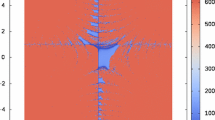Abstract
The minimal numberμ(S) of generators of a multidimensional systemS is constructively determined. Such anS is the solution space of a linear system of partial differential or difference equations with constant coefficients. The main theorem generalizes recent results of Heij and Zampieri who calculated the numberμ(S) in the one- (resp. two-) dimensional discrete case. There is also a direct connection with Macaulay's inverse systems in the multidimensional discrete situation, in particular with his principal systems characterized by the relationμ(S)⩽1. It is surprising that, for dimensions greater than one, very many “large” systems are principal in this sense.
Similar content being viewed by others
References
Bayer, D., and D. Mumford, What Can be Computed in Algebraic Geometry, Preprint, 1992.
Bourbaki, N.,Commutative Algebra, Hermann, Paris, 1972.
Bourbaki, N.,Algèbre, Chapter 10, Masson, Paris, 1980.
Ehrenpreis, L.,Fourier Analysis in Several Complex Variables, Wiley-Interscience, New York, 1970.
Eisenbud, D., C. Huneke, and W. Vasconcelos, Direct Methods for Primary Decomposition,Invent. Math. 110 (1992), 207–236.
Gianni, P., B. Trager, and G. Zacharias, Gröbner Basis and Primary Decomposition of Polynomial Ideals,J. Symbol. Comput. 6 (1988), 149–168.
Grauert, H., and R. Remmert,Analytische Stellenalgebren, Springer-Verlag, Heidelberg, 1971.
Grauert, H., and R. Remmert,Coherent Analytic Sheaves, Springer-Verlag, Heidelberg, 1984.
Grauert, H., and R. Remmert,Theorie der Steinschen Räume, Springer-Verlag, Heidelberg, 1977.
Gröbner, W., Über die algebraischen Eigenschaften der Integrale von linearen Differentialgleichungen mit konstanten Koeffizienten,Monatsh. Math. Phys. 47 (1939), 247–284.
Heij, C., Exact Modelling and Identifiability of Linear Systems,Automatica 28 (1992), 325–344.
Macaulay, F. S.,The Algebraic Theory of Modular Systems, Cambridge University Press, 1916; reprint by Stechert-Hafner Service Agency, New York, 1964.
Malgrange, B., Systèmes diffèrentiels à coefficients constants, inSèminaire Bourbaki, Vol. 1962/63, 246.01–246.11.
Matlis, E., Injective Modules over Noetherian Rings,Pacific J. Math. 8 (1958), 511–528.
Matsumura, H.,Commutative Ring Theory, Cambridge University Press, Cambridge, 1986.
Nagata, M.,Local Rings, Interscience, New York, 1962.
Oberst, U., Multidimensional Constant Linear Systems,Acta Appl. Math. 20 (1990), 1–175.
Oberst, U., Finite Dimensional Systems of Partial Differential or Difference Equations,Adv. in Math., submitted June 1992.
Oberst, U., Variations on the Fundamental Principle for Linear Systems of Partial Differential and Difference Equations with Constant Coefficients,AAECC, submitted January 1993.
Palamodov, V. P.,Linear Differential Operators with Constant Coefficients, Springer-Verlag, Heidelberg, 1970.
Pauer, F., Gröbner Basen und ihre Anwendungen, inÜberblicke Mathematik (1991), pp. 127–149, Vieweg-Verlag, Braunschweig, 1990.
Serre, J.-P., Geométrie Algébrique et Geométrie Analytique,Ann. Inst. Fourier 6 (1955/56), 1–42.
Serre, J.-P.,Algèbre Locale, 2nd edn., Lecture Notes in Mathematics, Vol. 11, Springer-Verlag, Berlin, 1965.
Willems, J. C., From Time Series to Linear Systems — Part 1. Finite-Dimensional Linear Time-Invariant Systems,Automatica 22 (1986), 561–580.
Willems, J. C., From Time Series to Linear Systems — Part II. Exact Modeling,Automatica 22 (1986), 675–694.
Willems, J. C., Paradigms and Puzzles in the Theory of Dynamical Systems,IEEE Trans. Automat. Control 36 (1991), 259–294.
Zampieri, S., Exact Modeling of 2d-Arrays, Talk at the 2nd IFAC Conference on “System Structure and Control,” Prague, September 1992.
Zariski, O., and P. Samuel,Commutative Algebra, Vol. II, Van Nostrand, Princeton, NJ, 1960.
Author information
Authors and Affiliations
Rights and permissions
About this article
Cite this article
Oberst, U. On the minimal number of trajectories determining a multidimensional system. Math. Control Signal Systems 6, 264–288 (1993). https://doi.org/10.1007/BF01211623
Received:
Revised:
Issue Date:
DOI: https://doi.org/10.1007/BF01211623




